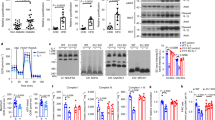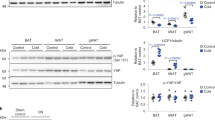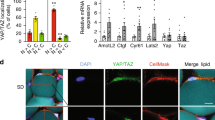Abstract
OBJECTIVE: Adipose tissue is now considered as an endocrine and secretory organ, and some adipocyte factors are thought to play a major role in the induction of insulin resistance in skeletal muscle. Here we tested the hypothesis that the crosstalk between fat and muscle involves activation of inhibitor κB Kinase (IKK) in the myocytes.
MEASUREMENTS: Adipocyte-conditioned culture medium was added to the muscle cells overnight, or human fat and muscle cells were kept in co-culture. Insulin signalling was subsequently analysed in the myocytes. Involvement of IKK was assessed using I229, a highly specific inhibitor of the IKK complex.
RESULTS: Adipocyte-conditioned medium strongly inhibited insulin-induced serine phosphorylation of Akt in myocytes with a rapid parallel activation of the nuclear factor κB pathway in these cells. Conditioned medium lacking the perturbation of insulin signalling did not activate NF-κB. Insulin signalling to Akt was completely abrogated under co-culture conditions. The IKK inhibitor I229 did not affect protein expression of Akt, but fully restored insulin action in myocytes subjected to co-culture.
CONCLUSION: These data show that the release of fat cell factors may rapidly induce insulin resistance in human skeletal muscle cells. This process appears to be mediated by an IKK/NF-κB dependent pathway. We suggest that inhibitors of IKK would be of use to counteract the negative crosstalk between fat and muscle.
This is a preview of subscription content, access via your institution
Access options
Subscribe to this journal
Receive 12 print issues and online access
$259.00 per year
only $21.58 per issue
Buy this article
- Purchase on Springer Link
- Instant access to full article PDF
Prices may be subject to local taxes which are calculated during checkout







Similar content being viewed by others
References
Groop LC . Insulin resistance: the fundamental trigger of type 2 diabetes. Diabetes Obes Metab 1999; 1 (Suppl 1): 1–7.
Ryder JW, Gilbert M, Zierath JR . Skeletal muscle and insulin sensitivity: pathophysiological alterations. Front Biosci 2001; 6: D154–D163.
Ferrannini E, Natali A, Bell P, Cavallo-Perin P, Lalic N, Mingrone G . Insulin resistance and hypersecretion in obesity. J Clin Invest 1997; 100: 1166–1173.
Goodpaster BH, Thaete FL, Kelley DE . Thigh adipose tissue distribution is associated with insulin resistance in obesity and in type 2 diabetes mellitus. Am J Clin Nutr 2000; 71: 885–892.
Mohamed-Ali V, Pinkney JH, Coppack SW . Adipose tissue as an endocrine and paracrine organ. Int J Obes Relat Metab Disord 1998; 22: 1145–1158.
Dietze D, Koenen M, Roehrig K, Horikoshi H, Hauner H, Eckel J . Impairment of insulin signaling in human skeletal muscle cells by co-culture with human adipocytes. Diabetes 2002; 51: 2369–2376.
Hotamisligil GS, Peraldi P, Budavari A, Ellis R, White MF, Spiegelman BM . IRS-1 mediated inhibition of insulin receptor tyrosine kinase activity in TNF-alpha- and obesity-induced insulin resistance. Science 1996; 271: 665–668.
Griffin ME, Marcucci MJ, Cline GW, Bell K, Barucci N, Lee D, Goodyear LJ, Kraegen EW, White MF, Shulman GI . Free fatty acid induced insulin resistance is associated with activation of protein kinase C theta and alterations in the insulin signaling cascade. Diabetes 1999; 48: 1270–1274.
Kolter T, Uphues I, Eckel J . Molecular analysis of insulin resistance in isolated ventricular cardiomyocytes of obese zucker rats. Am J Physiol 1997; 273: E59–E67.
Yuan M, Konstantopoulos N, Lee J, Hansen L, Li ZW, Karin M, Shoelson SE . Reversal of obesity- and diet-induced insulin resistance with salicylates or targeted disruption of Ikkbeta. Science 2001; 293: 1673–1677.
Kim JK, Kim YJ, Fillmore JJ, Chen Y, Moore I, Lee J, Yuan M, Li ZW, Karin M, Perret P, Shoelson SE, Shulman GI . Prevention of fat induced insulin resistance by salicylate. J Clin Invest 2001; 108: 437–446.
Gao Z, Hwang D, Bataille F, Lefevre M, York D, Quon MJ, Ye J . Serine phosphorylation of insulin receptor substrate 1 by inhibitor kappa B kinase complex. J Biol Chem 2002; 277: 48115–48121.
Karin M . The beginning of the end: IκB Kinase (IKK) and NF-κB activation. J Biol Chem 1999; 274: 27339–27342.
Ghosh S, Karin M . Missing pieces in the NF-kappaB puzzle. Cell 2002; 109: S81–S96.
Das UN . Is metabolic syndrome X an inflammatory condition? Exp Biol Med 2002; 227: 989–997.
Hauner H, Petruschke T, Russ M, Rohrig K, Eckel J . Effects of tumour necrosis factor alpha (TNF alpha) on glucose transport and lipid metabolism of newly-differentiated human fat cells in cell culture. Diabetologia 1995; 38: 764–771.
Wichelhaus A, Russ M, Petersen S, Eckel J . G protein expression and adenylate cyclase regulation in ventricular cardiomyocytes from STZ-diabetic rats. Am J Physiol 1994; 267: H548–H555.
Hajduch E, Litherland GJ, Hundal HS . Protein kinase B (PKB/Akt)—a key regulator of glucose transport? FEBS Lett 2001; 492: 199–203.
Päth G, Bornstein SR, Gurniak M, Chrousos GP, Scherbaum WA, Hauner H . Human breast adipocytes express interleukin-6 (IL-6) and its receptor system: increased IL-6 production by beta-adrenergic activation and effects of IL-6 on adipocyte function. J Clin Endocrinol Metab 2001; 86: 2281–2288.
Haffner SM . Insulin resistance, inflammation, and the prediabetic state. Am J Cardiol 2003; 92: 18J–26J.
Lyon CJ, Law RE, Hsueh WA . Minireview: adiposity, inflammation, and atherogenesis. Endocrinology 2003; 144: 2195–2200.
Festa A, D'Agostino Jr R, Tracy RP, Haffner SM . Insulin resistance atherosclerosis study. Elevated levels of acute-phase proteins and plasminogen activator inhibitor-1 predict the development of type 2 diabetes: the insulin resistance atherosclerosis study. Diabetes 2002; 51: 1131–1137.
Pradhan AD, Manson JE, Rifai N, Buring JE, Ridker PM . C-reactive protein, interleukin-6, and risk of developing type 2 diabetes mellitus. JAMA 2001; 286: 327–334.
Yudkin JS, Stehouwer CD, Emeis JJ, Coppack SW . C-reactive protein in healthy subjects: associations with obesity, insulin resistance, and endothelial dysfunction: a potential role for cytokines originating from adipose tissue? Arterioscler Thromb Vasc Biol 1999; 19: 972–978.
Coppack SW . Pro-inflammatory cytokines and adipose tissue. Proc Nutr Soc 2001; 60: 349–356.
Kielstein JT, Becker B, Graf S, Brabant G, Haller H, Fliser D . Increased resistin blood levels are not associated with insulin resistance in patients with renal disease. Am J Kidney Dis 2003; 42: 62–66.
Maebuchi M, Machidori M, Urade R, Ogawa T, Moriyama T . Low resistin levels in adipose tissues and serum in high-fat fed mice and genetically obese mice: development of an ELISA system for quantification of resistin. Arch Biochem Biophys 2003; 416: 164–170.
Karin M, Ben-Neriah Y . Phosphorylation meets ubiquitination: the control of NF-[kappa]B activity. Annu Rev Immunol 2000; 18: 621–663.
Itani SI, Ruderman NB, Schmieder F, Boden G . Lipid-induced insulin resistance in human muscle is associated with changes in diacylglycerol, protein kinase C, and IkappaB-alpha. Diabetes 2002; 51: 2005–2011.
Hotamisligil GS . The role of TNFalpha and TNF receptors in obesity and insulin resistance. J Intern Med 1999; 245: 621–625.
Shulman GI . Cellular mechanisms of insulin resistance. J Clin Invest 2000; 106: 171–176.
Feinstein R, Kanety H, Papa MZ, Lunenfeld B, Karasik A . Tumor necrosis factor-alpha suppresses insulin-induced tyrosine phosphorylation of insulin receptor and its substrates. J Biol Chem 1993; 268: 26055–26058.
Gao Z, Zuberi A, Quon MJ, Dong Z, Ye J . Aspirin inhibits serine phosphorylation of insulin receptor substrate 1 in tumor necrosis factor-treated cells through targeting multiple serine kinases. J Biol Chem 2003; 278: 24944–24950.
Ruan H, Pownall HJ, Lodish HF . Troglitazone antagonizes tumor necrosis factor-alpha-induced reprogramming of adipocyte gene expression by inhibiting the transcriptional regulatory functions of NF-kappaB. J Biol Chem 2003; 278: 28181–28192.
Acknowledgements
This work was supported by the Ministerium für Wissenschaft und Forschung des Landes Nordrhein-Westfalen, the Bundesministerium für Gesundheit, EU COST Action B 17, the Deutsche Forschungsgemeinschaft (FOR-441, TP7), the Deutsche Diabetes-Stiftung and in part by a grant from Aventis Pharma, Frankfurt, Germany. We wish to thank Professor R Olbrisch and his team, Department of Plastic Surgery, Florence-Nightingale-Hospital Düsseldorf, for support in obtaining adipose tissue samples. The secretarial assistance of Birgit Hurow is gratefully acknowledged.
Author information
Authors and Affiliations
Corresponding author
Rights and permissions
About this article
Cite this article
Dietze, D., Ramrath, S., Ritzeler, O. et al. Inhibitor κB kinase is involved in the paracrine crosstalk between human fat and muscle cells. Int J Obes 28, 985–992 (2004). https://doi.org/10.1038/sj.ijo.0802701
Received:
Revised:
Accepted:
Published:
Issue Date:
DOI: https://doi.org/10.1038/sj.ijo.0802701
Keywords
This article is cited by
-
Interleukin-6 mimics insulin-dependent cellular distribution of some cytoskeletal proteins and Glut4 transporter without effect on glucose uptake in 3T3-L1 adipocytes
Histochemistry and Cell Biology (2022)
-
Abscisic acid enriched fig extract promotes insulin sensitivity by decreasing systemic inflammation and activating LANCL2 in skeletal muscle
Scientific Reports (2020)
-
Interleukin-6 affects pacsin3, ephrinA4 expression and cytoskeletal proteins in differentiating primary skeletal myoblasts through transcriptional and post-transcriptional mechanisms
Cell and Tissue Research (2020)
-
Factors which modulate the rates of skeletal muscle mass loss in non-small cell lung cancer patients: a pilot study
Supportive Care in Cancer (2017)
-
Mechanisms of inflammatory responses and development of insulin resistance: how are they interlinked?
Journal of Biomedical Science (2016)



